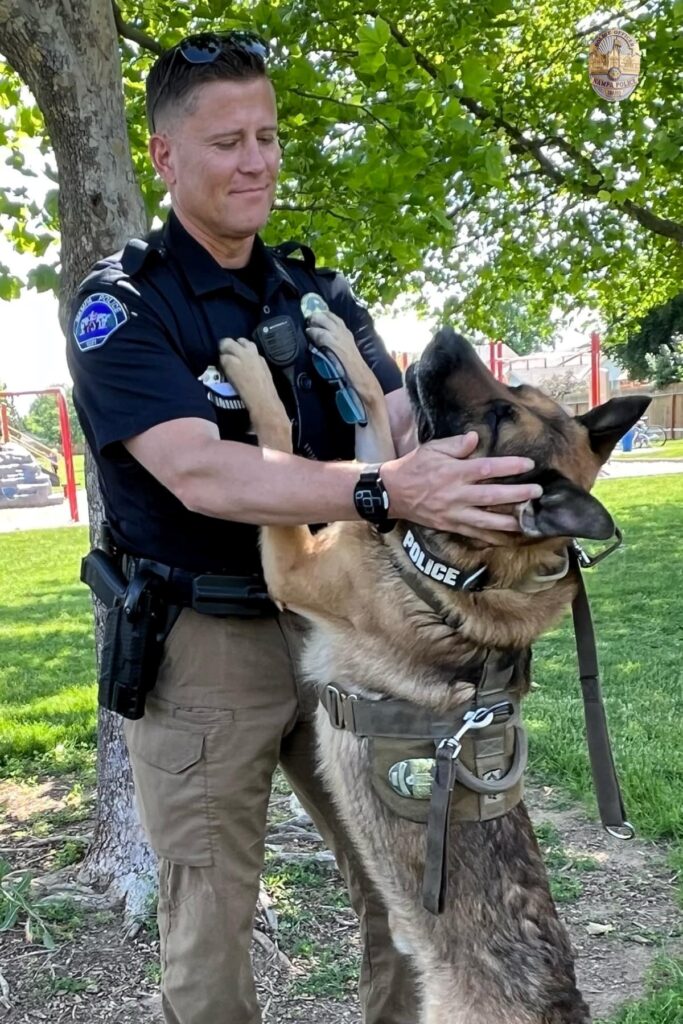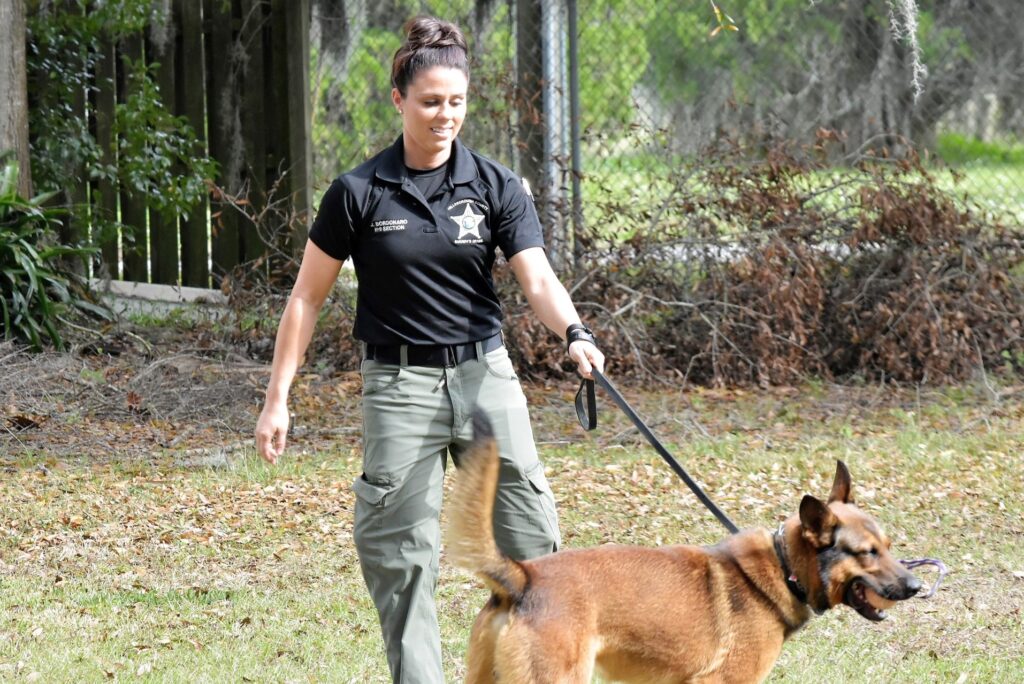
Nampa, Idaho police department canine exposé by news reporter Savannah Hankard’s coverage entailed her donning the full bite-suit and catching a canine clench—in other words, the canine clench caught her.
As soon as the missile launched and nailed its target, the words “Holy crap!” instantly slipped out of her mouth, compelled by the police dog’s grasp attached to its rocketing body whose velocity spun her like a top.
She said it was “intense” and also made it abundantly clear that she “would never want to be the bad guy ever…ever…ever!”
Grateful for the facts direct from the professional sources, the Nampa Police Department administration extended kudos for her coverage of the canine teams…and sort of extended an olive branch, thanking “Savannah Hankard, CBS 2 Boise, for your report on our K-9 Unit — and for being such a good sport. Sorry about the K-9 tackle.”
The punctuation Ms. Hankard placed at the finale of her report is solid gold: “Our community is safer thanks to man’s best friend!”
For sure…that goes for every community with the fortune of a police canine unit working the mean streets and sniffing out people harboring sinister plans. For those police agencies that do not have their own canine corps, requesting fur missiles from larger law enforcement organizations is the go-to alternative when the need arises.
Police canines command respect, and most fugitives fleeing or hiding honor that by surrendering peacefully. Others, however, choose to play the Joker card and typically win the clench (minus the bite suit) endured by Ms. Hankard.
Ideal, though, are the men and women who don the uniform and pin the badge before heading out to combat crime, symbiotically working with highly-trained and super-skilled canines, forming unshakable bonds galvanized to prevent bad actors from victimizing innocent individuals in society.
As in prior articles written about police dog teams, the human counterparts seem to be overjoyed in having such a thrilling, unfailing, loyal, driven, hard-working partner. Ms. Hankard covered that in her journalistic analysis of this feat among law enforcement agencies.

(Photo courtesy of the Nampa Police Department.)
On that note, she is among the ostensibly rare few reporters working in media who courageously step forward to physically engage in the subject matter, not just observe from the sidelines, and then write some words about it.
Delving into Ms. Hankard’s portfolio of news coverage, it seems apparent she is among the pro-public safety reporters who respect police heroes, dishing out facts about what it is like to navigate as a first responder—the pros, the cons, and the imperative nature of having brave folks step up and fight the good fight.
Around the turn of the New Year, Ms. Hankard covered a house fire, from which two Caldwell, Idaho police officers are credited with saving several lives from the inferno, pulling them to safety.
This brand of reporting surely beats the talking heads that take the easy road by parroting what all other anti-police sorts spout out while beating their chest…as if everyone listening ought to gullibly follow their propagandized perspectives (bold-faced falsities).
Media Relations
As often as I visit the websites of various law enforcement agencies around the country, it is becoming more common that I notice landing pages specifically for media relations, with police personnel whose task it is to coordinate reporters and members of the force, meeting in the middle to conduct exposés such as the one up top (Nampa PD’s canine unit).
On the Gulf Coast of Florida, the Sarasota Police Department has “Media Day” on their annual calendar of events, inviting any journalists to partake in police training scenarios realistically exposing reporters to all the challenges bona fide cops confront and deal with.
From experience years ago, media members were always welcome at my department’s events that showcased agency assets, our officers exhibiting the operational wares and exemplifying how they are used for effective crime suppression.
Sadly, it was rare that any reporter volunteered to step into roles ordinarily occupied by certified cops, performing undeniably dangerous operations manifested to thwart malice perpetrated by bad people.
If there is ever a situation for journalists to speak from the pulpit about the rigors and life-threatening aspects of police work, during any given tour of duty of a law enforcement officer, participating in scenarios overseen by police instructors is as real as it gets for anyone in civilian capacity.
Looking back on highly successful long-running shows such as “COPS,” media crews armed with cameras and boom mics, wrapped in ballistic vests (signaling the perils that will endanger their existence, cop or not), crammed into police cruisers and hit the beats all over America.
“Live PD” is another example whereby TV production crews rode shotgun with bona fide law enforcement officers, recording situations as they unfolded, requiring up-close encounters to successfully garner footage for viewers.
These reality-show live-action media folks know what it is like to be a cop in the United States, mostly, without enduring the demands of a full police academy. Some journos did it for reporting purposes, albeit the shortened version known as the Citizens Police Academy.
Other journalists explored the law enforcement officer aspirant’s journey to/through the police academy and reported on the breadth of it all.
Seems a requisite ingredient for any elected officials scaling campaigns holding office would be to at least navigate the obstacles and encounter the perils cops confront, necessary training to overcome myriad occupational hazards, and, of course, straight-talk about how politics often pollute the public safety pot. This way, politicos can refrain from going with the anti-cop flow and be objective when using conferred authority to make crucial decisions concerning first responders responsible for public safety standards.
Some fantasies materialize in real life…
So do nightmares, just like the one perpetrated by some California elected officials who deemed dogs ought to be canceled from certain forms of police work because they are “racist.”
Going to the Dogs
Circling back to our topic today, and looking at training academies specifically for canines, my neck of the woods is a prime example of the high value in law enforcement canines and legislative investments made toward continued success by those engaged in law enforcement realms on behalf of the community.
According to Florida Politics, state lawmakers earmarked $2 million “to the Hillsborough County Sheriff’s Office Regional K-9 program” with all funds to be “used to construct a new law enforcement K-9 training and boarding facility for the [sheriff’s] office.
“There, the K-9 and handler teams can train and have secure boarding. The facility would also provide a space for other organizations’ K-9 and handler teams to train.” This means the facility is available to neighboring police agencies’ K9 units, mimicking Mutual Aid Agreements that are common among law enforcement organizations and designed to share assets/facilities/intelligence.

(Photo courtesy of the Hillsborough County Sheriff’s Office.)
Florida Politics reporter Kelly Hayes continued: “The goal of the new facility is to enhance HCSO’s K-9 team in areas of patrol, narcotics, and explosives detection, and tracking of missing or endangered persons, according to the request. The facility would be equipped with features like secure explosives and narcotics training aids, scent walls, a classroom, spaces to train K-9s and personnel, and kennels with indoor and outdoor access.”
The sheriff’s office submitted a funding request to build on the successes of its Canine Unit.
Recently, HCSO deputies exemplified how canines are so crucial, notching another win when one of their dogs sniffed a piece of clothing belonging to an 11-year-old girl who was reported as missing/endangered.
Per Fox13 News Tampa Bay reporterAriel Plasencia: “They take the pillowcase from the [bedding of the] 11-year-old and let this puppy sniff the pillowcase,” Hillsborough Sheriff Chad Chronister said. “That’s all she had to go on.” She is K-9 Mary Lou, a Hound.
With only the child’s shirt scent, the trained bloodhound and deputy handler tracked the girl to a public restroom in a county park, safely returning her home…but not before K9 Mary Lou offered love and kisses to the youngster. Have a look…
There are gobs of success stories involving police canines serving as catalysts sniffing out and locking up bad actors, locating missing persons, and garnering attention as public relations assets, making communities safer and sanctified.
Perhaps that is why McGruff the Crime Dog is iconic.